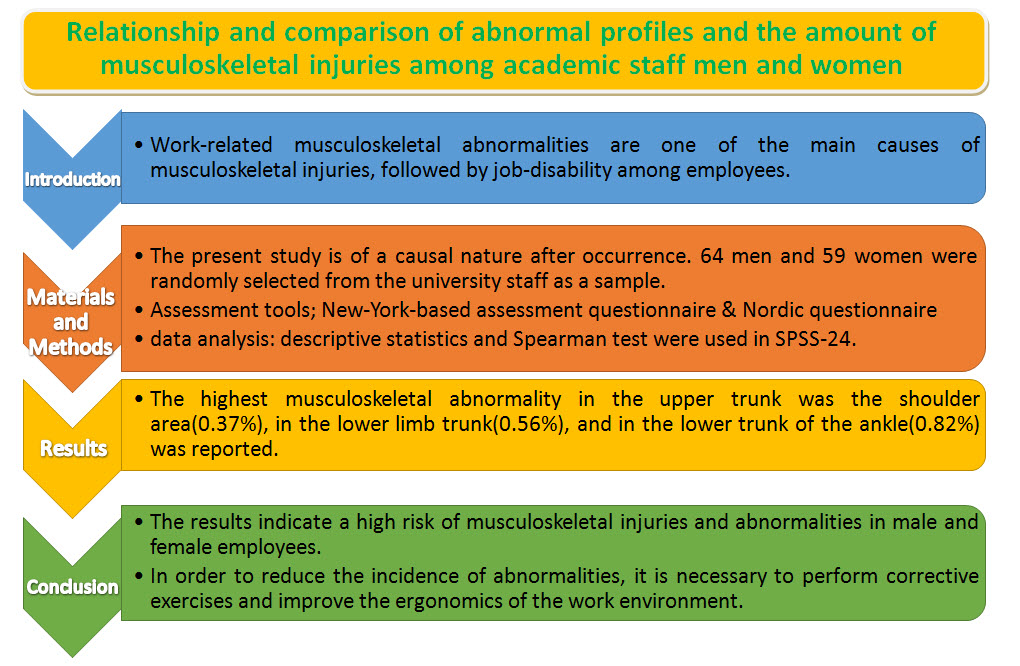Volume 12, Issue 2 (6-2022)
J Health Saf Work 2022, 12(2): 432-445 |
Back to browse issues page
Download citation:
BibTeX | RIS | EndNote | Medlars | ProCite | Reference Manager | RefWorks
Send citation to:



BibTeX | RIS | EndNote | Medlars | ProCite | Reference Manager | RefWorks
Send citation to:
Babaei Khorzoghi M, Hoseini S A, Manshuri M, Batavani M R, Mahdieh L. Relationship of abnormal profiles and the prevalence of musculoskeletal disorders among academic staff men and women. J Health Saf Work 2022; 12 (2) :432-445
URL: http://jhsw.tums.ac.ir/article-1-6693-en.html
URL: http://jhsw.tums.ac.ir/article-1-6693-en.html
Mojtaba Babaei Khorzoghi * 
 1, Sayed Ali Hoseini2
1, Sayed Ali Hoseini2 
 , Mahnaz Manshuri2
, Mahnaz Manshuri2 
 , Mohamad Reza Batavani2
, Mohamad Reza Batavani2 
 , Leili Mahdieh2
, Leili Mahdieh2 


 1, Sayed Ali Hoseini2
1, Sayed Ali Hoseini2 
 , Mahnaz Manshuri2
, Mahnaz Manshuri2 
 , Mohamad Reza Batavani2
, Mohamad Reza Batavani2 
 , Leili Mahdieh2
, Leili Mahdieh2 

1- Center of Physical Education, Isfahan University of Technology, Isfahan, Iran , babaei@cc.iut.ac.ir
2- Center of Physical Education, Isfahan University of Technology, Isfahan, Iran
2- Center of Physical Education, Isfahan University of Technology, Isfahan, Iran
Abstract: (1450 Views)
Introduction: Work-related musculoskeletal abnormalities are one of the main causes of musculoskeletal injuries, followed by job-disability among employees. The purpose of this study was to investigate the relationship between abnormal profiles and the prevalence of musculoskeletal disorders (MSDs) among academic staff men and women.
Material and Methods: The present study is of a causal nature after occurrence. The statistical population consisted of all employees of Isfahan University of Technology in 2018. A random sample of 64 men and 59 women were recruited as the study sample. A New-York-based assessment questionnaire was used to assess musculoskeletal-abnormalities and a Nordic questionnaire was used to assess the extent of MSDs. For data analysis, descriptive statistics and Spearman test were used in SPSS version24 software.
Results: The highest musculoskeletal abnormality in the upper limb was observed in shoulder area (0.37%) and among the lower limbs the ankle (0.82%) was reported as the highest. In terms of correlation between pain, disability and injuries and MSDs with gender in the last 7 days, there was the highest correlation with shoulder (r=0.377), wrist (r=0.401) in the last 12 months and musculoskeletal abnormalities with shoulder area (r = 0.411). There was a significant difference in the prevalence of pain and disability with injury in the shoulder area (P = 0.001), wrist (P = 0.001), back (P = 0.002), buttocks (P = 0.032) and knees (P = 0.006).
Conclusion: The results indicate a high risk of MSDs and abnormalities in male and female employees. In order to reduce the incidence of abnormalities, it is necessary to perform corrective exercises and improve the ergonomics conditions of the work environment.
Material and Methods: The present study is of a causal nature after occurrence. The statistical population consisted of all employees of Isfahan University of Technology in 2018. A random sample of 64 men and 59 women were recruited as the study sample. A New-York-based assessment questionnaire was used to assess musculoskeletal-abnormalities and a Nordic questionnaire was used to assess the extent of MSDs. For data analysis, descriptive statistics and Spearman test were used in SPSS version24 software.
Results: The highest musculoskeletal abnormality in the upper limb was observed in shoulder area (0.37%) and among the lower limbs the ankle (0.82%) was reported as the highest. In terms of correlation between pain, disability and injuries and MSDs with gender in the last 7 days, there was the highest correlation with shoulder (r=0.377), wrist (r=0.401) in the last 12 months and musculoskeletal abnormalities with shoulder area (r = 0.411). There was a significant difference in the prevalence of pain and disability with injury in the shoulder area (P = 0.001), wrist (P = 0.001), back (P = 0.002), buttocks (P = 0.032) and knees (P = 0.006).
Conclusion: The results indicate a high risk of MSDs and abnormalities in male and female employees. In order to reduce the incidence of abnormalities, it is necessary to perform corrective exercises and improve the ergonomics conditions of the work environment.
Type of Study: Research |
Received: 2022/06/26 | Accepted: 2022/06/22 | Published: 2022/06/22
Received: 2022/06/26 | Accepted: 2022/06/22 | Published: 2022/06/22
Send email to the article author
| Rights and permissions | |
 |
This work is licensed under a Creative Commons Attribution-NonCommercial 4.0 International License. |




